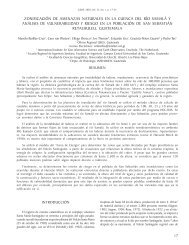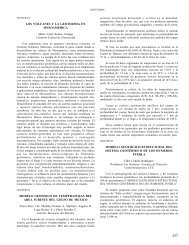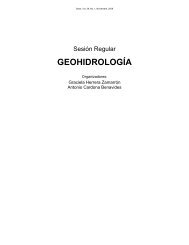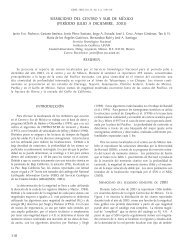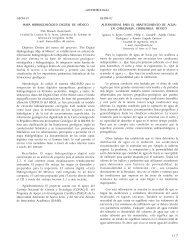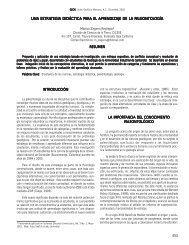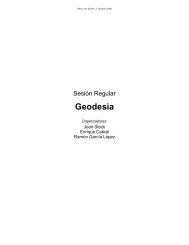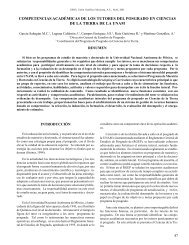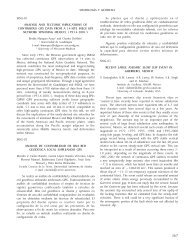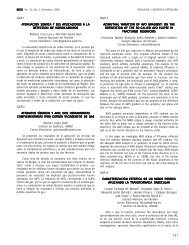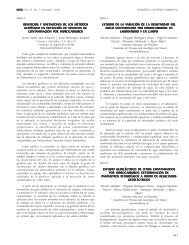- Page 1 and 2:
Ortiz: Vientos Santa Ana Volumen 30
- Page 3 and 4:
Geos, Vol. 30, No. 1, Noviembre, 20
- Page 5 and 6:
Geos, Vol. 30, No. 1, Noviembre, 20
- Page 7 and 8:
Geos, Vol. 30, No. 1, Noviembre, 20
- Page 9 and 10:
Geos, Vol. 30, No. 1, Noviembre, 20
- Page 11 and 12:
Geos, Vol. 30, No. 1, Noviembre, 20
- Page 13 and 14:
Geos, Vol. 30, No. 1, Noviembre, 20
- Page 15 and 16:
Geos, Vol. 30, No. 1, Noviembre, 20
- Page 17 and 18:
Geos, Vol. 30, No. 1, Noviembre, 20
- Page 19 and 20:
Geos, Vol. 30, No. 1, Noviembre, 20
- Page 21 and 22:
Geos, Vol. 30, No. 1, Noviembre, 20
- Page 23 and 24:
Geos, Vol. 30, No. 1, Noviembre, 20
- Page 25 and 26:
Geos, Vol. 30, No. 1, Noviembre, 20
- Page 27 and 28:
Geos, Vol. 30, No. 1, Noviembre, 20
- Page 29 and 30:
Geos, Vol. 30, No. 1, Noviembre, 20
- Page 31 and 32:
Geos, Vol. 30, No. 1, Noviembre, 20
- Page 33 and 34:
Geos, Vol. 30, No. 1, Noviembre, 20
- Page 35 and 36:
Geos, Vol. 30, No. 1, Noviembre, 20
- Page 37 and 38:
Geos, Vol. 30, No. 1, Noviembre, 20
- Page 39 and 40:
Geos, Vol. 30, No. 1, Noviembre, 20
- Page 41 and 42:
Geos, Vol. 30, No. 1, Noviembre, 20
- Page 43 and 44:
Geos, Vol. 30, No. 1, Noviembre, 20
- Page 45 and 46:
Geos, Vol. 30, No. 1, Noviembre, 20
- Page 47 and 48:
Geos, Vol. 30, No. 1, Noviembre, 20
- Page 49 and 50:
Geos, Vol. 30, No. 1, Noviembre, 20
- Page 51 and 52:
Geos, Vol. 30, No. 1, Noviembre, 20
- Page 53 and 54:
Geos, Vol. 30, No. 1, Noviembre, 20
- Page 55 and 56:
Geos, Vol. 30, No. 1, Noviembre, 20
- Page 57 and 58:
Geos, Vol. 30, No. 1, Noviembre, 20
- Page 59 and 60:
Geos, Vol. 30, No. 1, Noviembre, 20
- Page 61 and 62:
Geos, Vol. 30, No. 1, Noviembre, 20
- Page 63 and 64:
Geos, Vol. 30, No. 1, Noviembre, 20
- Page 65 and 66:
Geos, Vol. 30, No. 1, Noviembre, 20
- Page 67 and 68:
Geos, Vol. 30, No. 1, Noviembre, 20
- Page 69 and 70:
Geos, Vol. 30, No. 1, Noviembre, 20
- Page 71 and 72:
Geos, Vol. 30, No. 1, Noviembre, 20
- Page 73 and 74:
Geos, Vol. 30, No. 1, Noviembre, 20
- Page 75 and 76:
Geos, Vol. 30, No. 1, Noviembre, 20
- Page 77 and 78:
Geos, Vol. 30, No. 1, Noviembre, 20
- Page 79 and 80:
Geos, Vol. 30, No. 1, Noviembre, 20
- Page 81 and 82:
Geos, Vol. 30, No. 1, Noviembre, 20
- Page 83 and 84:
Geos, Vol. 30, No. 1, Noviembre, 20
- Page 85 and 86:
Geos, Vol. 30, No. 1, Noviembre, 20
- Page 87 and 88:
Geos, Vol. 30, No. 1, Noviembre, 20
- Page 89 and 90:
Geos, Vol. 30, No. 1, Noviembre, 20
- Page 91 and 92:
Geos, Vol. 30, No. 1, Noviembre, 20
- Page 93 and 94:
Geos, Vol. 30, No. 1, Noviembre, 20
- Page 95 and 96:
Geos, Vol. 30, No. 1, Noviembre, 20
- Page 97 and 98:
Geos, Vol. 30, No. 1, Noviembre, 20
- Page 99 and 100:
Geos, Vol. 30, No. 1, Noviembre, 20
- Page 101 and 102:
Geos, Vol. 30, No. 1, Noviembre, 20
- Page 103 and 104:
Geos, Vol. 30, No. 1, Noviembre, 20
- Page 105 and 106:
Geos, Vol. 30, No. 1, Noviembre, 20
- Page 107 and 108:
Geos, Vol. 30, No. 1, Noviembre, 20
- Page 109 and 110:
Geos, Vol. 30, No. 1, Noviembre, 20
- Page 111 and 112:
Geos, Vol. 30, No. 1, Noviembre, 20
- Page 113 and 114:
Geos, Vol. 30, No. 1, Noviembre, 20
- Page 115 and 116:
Geos, Vol. 30, No. 1, Noviembre, 20
- Page 117 and 118:
Geos, Vol. 30, No. 1, Noviembre, 20
- Page 119 and 120:
Geos, Vol. 30, No. 1, Noviembre, 20
- Page 121 and 122:
Geos, Vol. 30, No. 1, Noviembre, 20
- Page 123 and 124:
Geos, Vol. 30, No. 1, Noviembre, 20
- Page 125 and 126:
Geos, Vol. 30, No. 1, Noviembre, 20
- Page 127 and 128:
Geos, Vol. 30, No. 1, Noviembre, 20
- Page 129 and 130:
Geos, Vol. 30, No. 1, Noviembre, 20
- Page 131 and 132:
Geos, Vol. 30, No. 1, Noviembre, 20
- Page 133 and 134:
Geos, Vol. 30, No. 1, Noviembre, 20
- Page 135 and 136:
Geos, Vol. 30, No. 1, Noviembre, 20
- Page 137 and 138:
Geos, Vol. 30, No. 1, Noviembre, 20
- Page 139 and 140:
Geos, Vol. 30, No. 1, Noviembre, 20
- Page 141 and 142:
Geos, Vol. 30, No. 1, Noviembre, 20
- Page 143 and 144:
Geos, Vol. 30, No. 1, Noviembre, 20
- Page 145 and 146:
Geos, Vol. 30, No. 1, Noviembre, 20
- Page 147 and 148:
Geos, Vol. 30, No. 1, Noviembre, 20
- Page 149 and 150:
Geos, Vol. 30, No. 1, Noviembre, 20
- Page 151 and 152:
Geos, Vol. 30, No. 1, Noviembre, 20
- Page 153 and 154:
Geos, Vol. 30, No. 1, Noviembre, 20
- Page 155 and 156:
Geos, Vol. 30, No. 1, Noviembre, 20
- Page 157 and 158:
Geos, Vol. 30, No. 1, Noviembre, 20
- Page 159 and 160:
Geos, Vol. 30, No. 1, Noviembre, 20
- Page 161 and 162:
Geos, Vol. 30, No. 1, Noviembre, 20
- Page 163 and 164:
Geos, Vol. 30, No. 1, Noviembre, 20
- Page 165 and 166:
Geos, Vol. 30, No. 1, Noviembre, 20
- Page 167 and 168: Geos, Vol. 30, No. 1, Noviembre, 20
- Page 169 and 170: Geos, Vol. 30, No. 1, Noviembre, 20
- Page 171 and 172: Geos, Vol. 30, No. 1, Noviembre, 20
- Page 173 and 174: Geos, Vol. 30, No. 1, Noviembre, 20
- Page 175 and 176: Geos, Vol. 30, No. 1, Noviembre, 20
- Page 177 and 178: Geos, Vol. 30, No. 1, Noviembre, 20
- Page 179 and 180: Geos, Vol. 30, No. 1, Noviembre, 20
- Page 181 and 182: Geos, Vol. 30, No. 1, Noviembre, 20
- Page 183 and 184: Geos, Vol. 30, No. 1, Noviembre, 20
- Page 185 and 186: Geos, Vol. 30, No. 1, Noviembre, 20
- Page 187 and 188: Geos, Vol. 30, No. 1, Noviembre, 20
- Page 189 and 190: Geos, Vol. 30, No. 1, Noviembre, 20
- Page 191 and 192: Geos, Vol. 30, No. 1, Noviembre, 20
- Page 193 and 194: Geos, Vol. 30, No. 1, Noviembre, 20
- Page 195 and 196: Geos, Vol. 30, No. 1, Noviembre, 20
- Page 197 and 198: Geos, Vol. 30, No. 1, Noviembre, 20
- Page 199 and 200: Geos, Vol. 30, No. 1, Noviembre, 20
- Page 201 and 202: Geos, Vol. 30, No. 1, Noviembre, 20
- Page 203 and 204: Geos, Vol. 30, No. 1, Noviembre, 20
- Page 205 and 206: Geos, Vol. 30, No. 1, Noviembre, 20
- Page 207 and 208: Geos, Vol. 30, No. 1, Noviembre, 20
- Page 209 and 210: Geos, Vol. 30, No. 1, Noviembre, 20
- Page 211 and 212: Geos, Vol. 30, No. 1, Noviembre, 20
- Page 213 and 214: Geos, Vol. 30, No. 1, Noviembre, 20
- Page 215 and 216: Geos, Vol. 30, No. 1, Noviembre, 20
- Page 217: Geos, Vol. 30, No. 1, Noviembre, 20
- Page 221 and 222: Geos, Vol. 30, No. 1, Noviembre, 20
- Page 223 and 224: Geos, Vol. 30, No. 1, Noviembre, 20
- Page 225 and 226: Geos, Vol. 30, No. 1, Noviembre, 20
- Page 227 and 228: Geos, Vol. 30, No. 1, Noviembre, 20
- Page 229 and 230: Geos, Vol. 30, No. 1, Noviembre, 20
- Page 231 and 232: Geos, Vol. 30, No. 1, Noviembre, 20
- Page 233 and 234: Geos, Vol. 30, No. 1, Noviembre, 20
- Page 235 and 236: Geos, Vol. 30, No. 1, Noviembre, 20
- Page 237 and 238: Geos, Vol. 30, No. 1, Noviembre, 20
- Page 239 and 240: Geos, Vol. 30, No. 1, Noviembre, 20
- Page 241 and 242: Recordamos a todos los miembros de



![Libro de resúmenes [revisión final, 172 páginas] - UGM](https://img.yumpu.com/51565067/1/190x245/libro-de-resamenes-revisian-final-172-paginas-ugm.jpg?quality=85)
